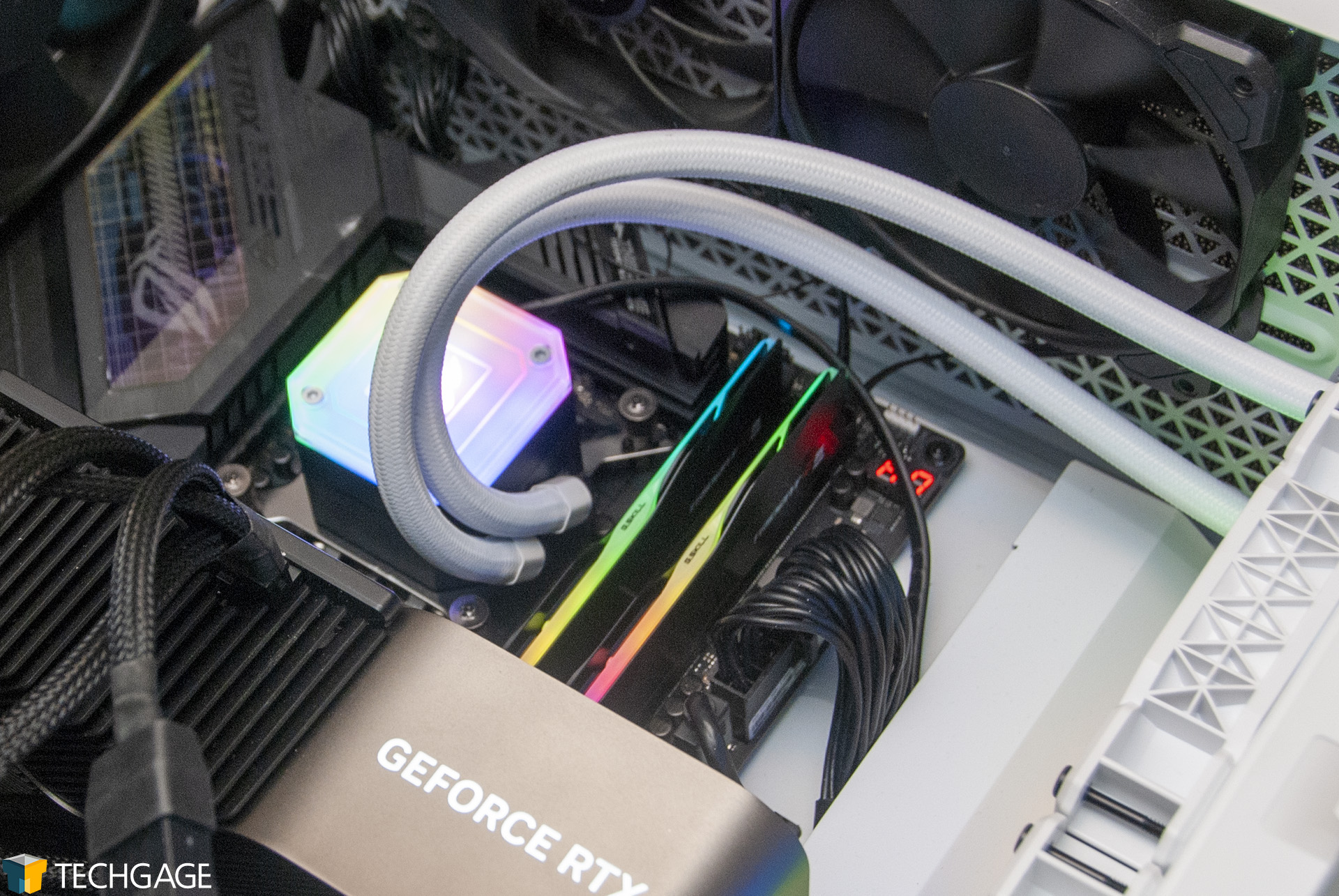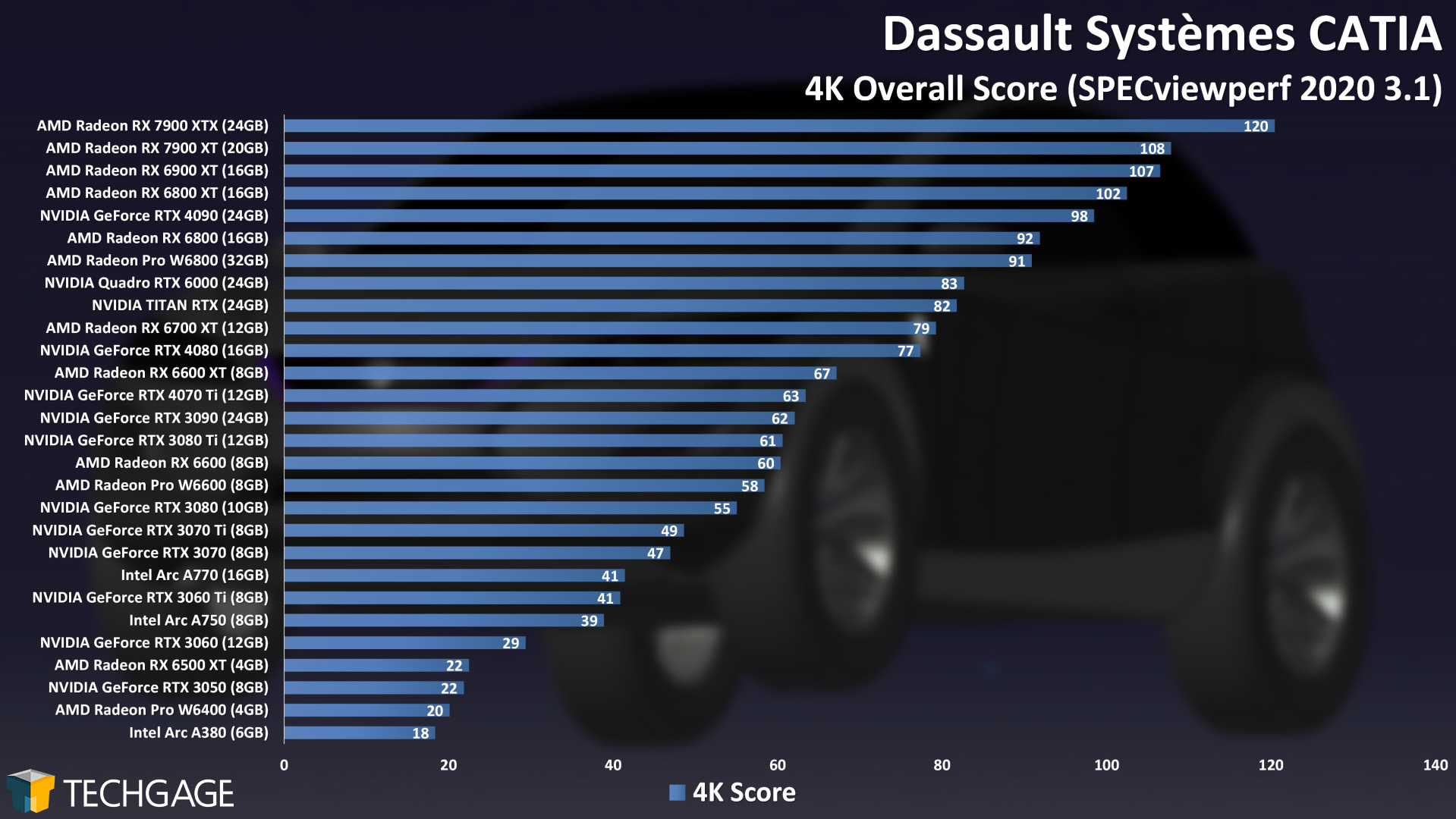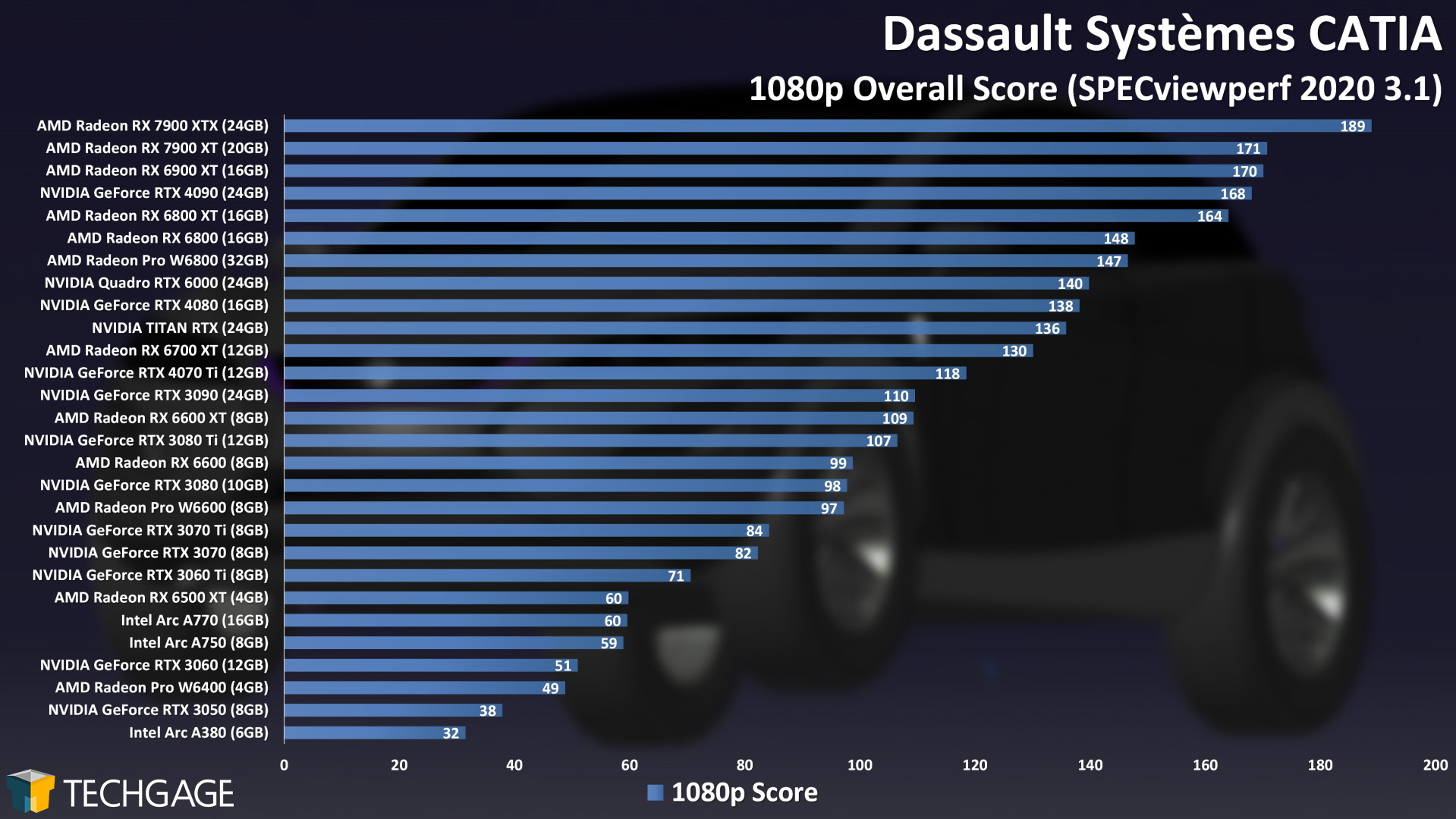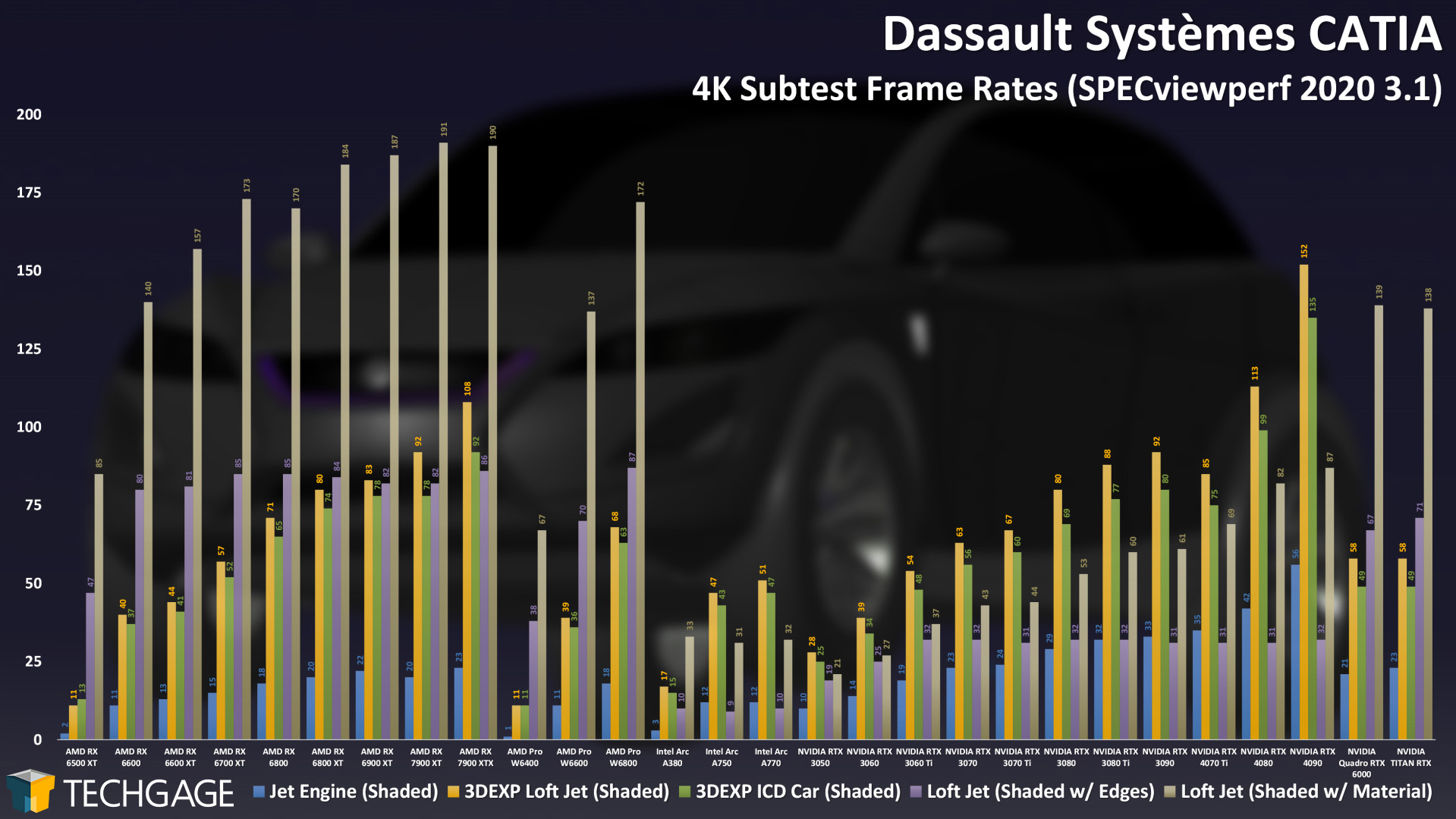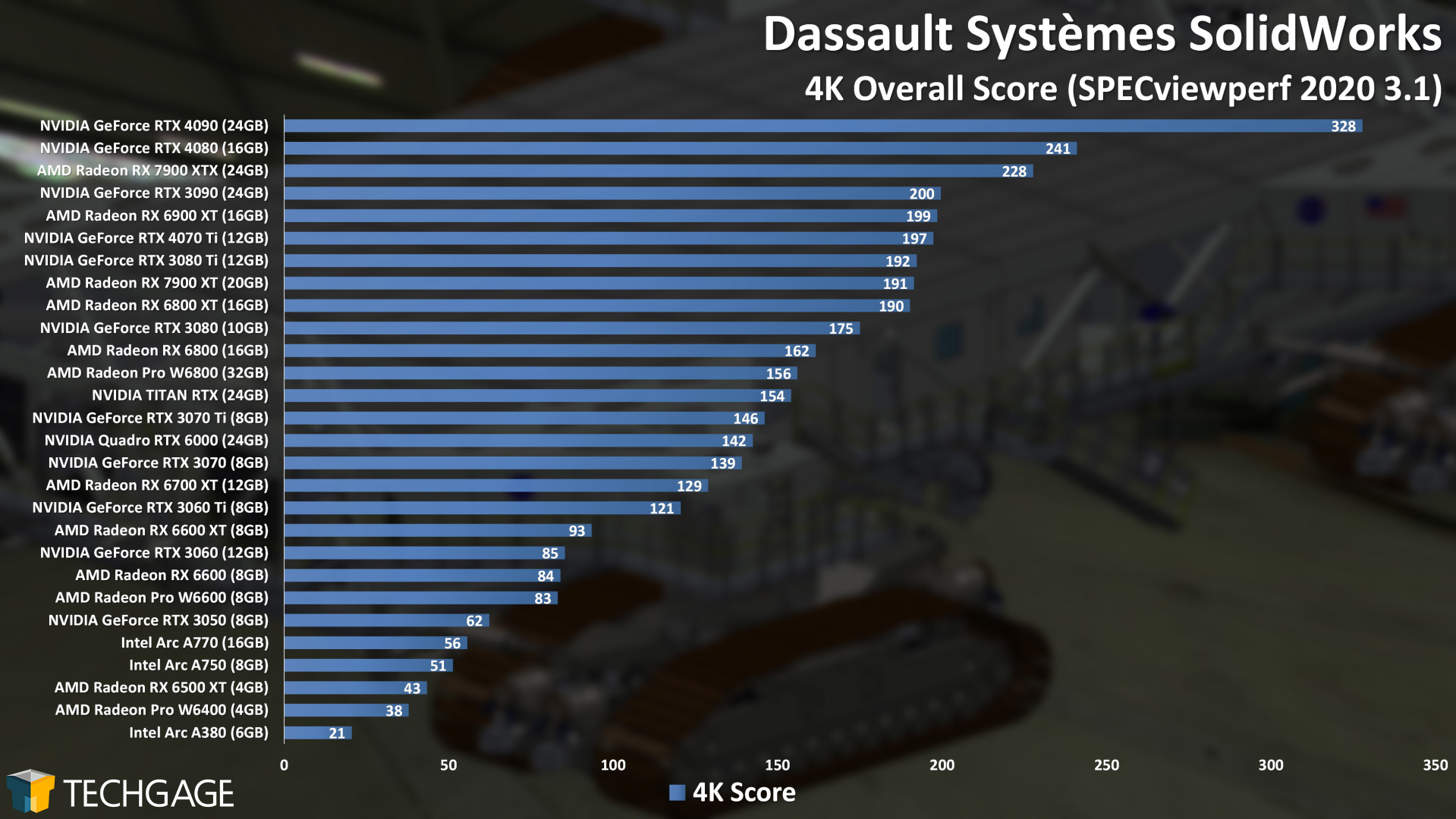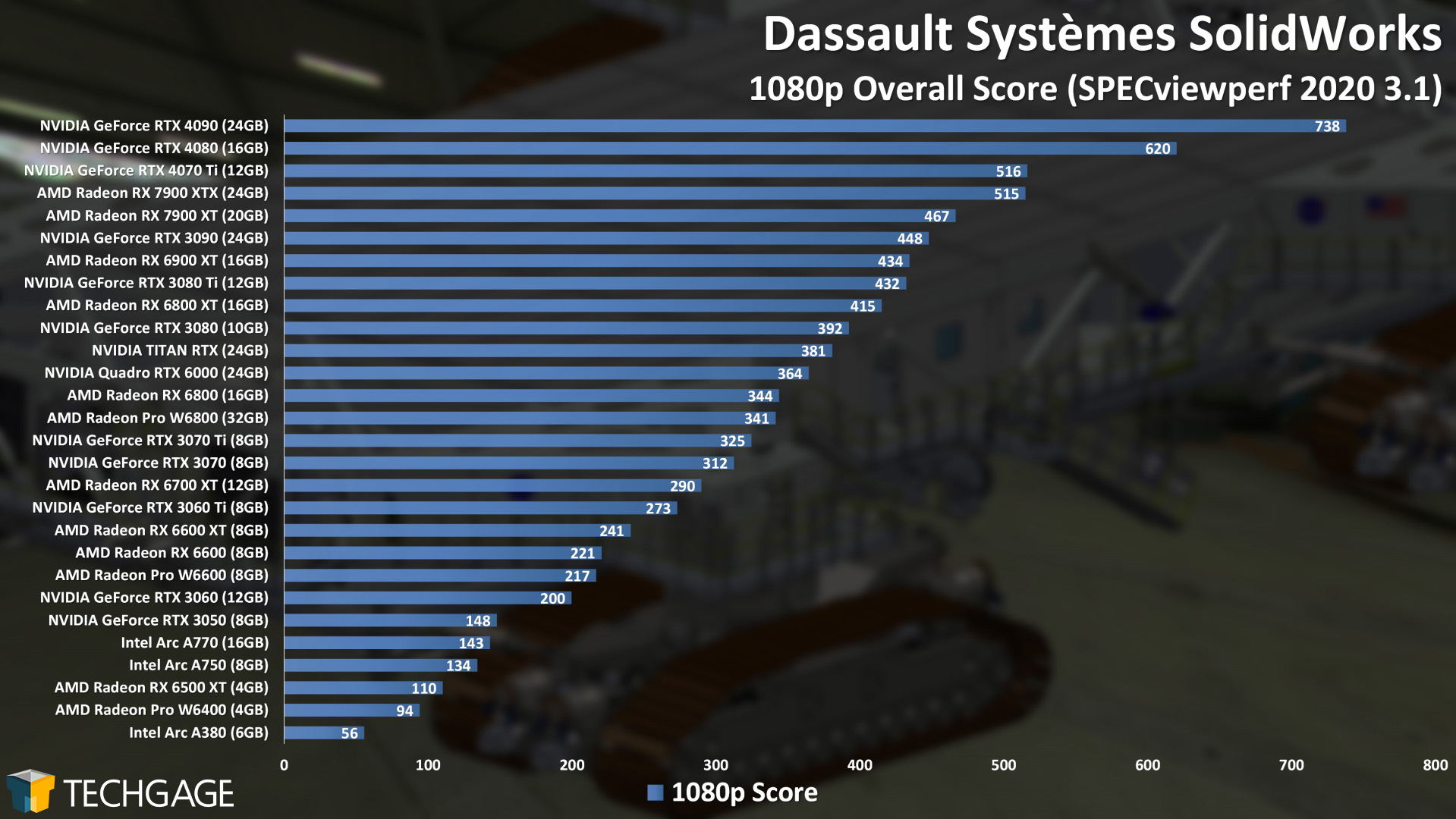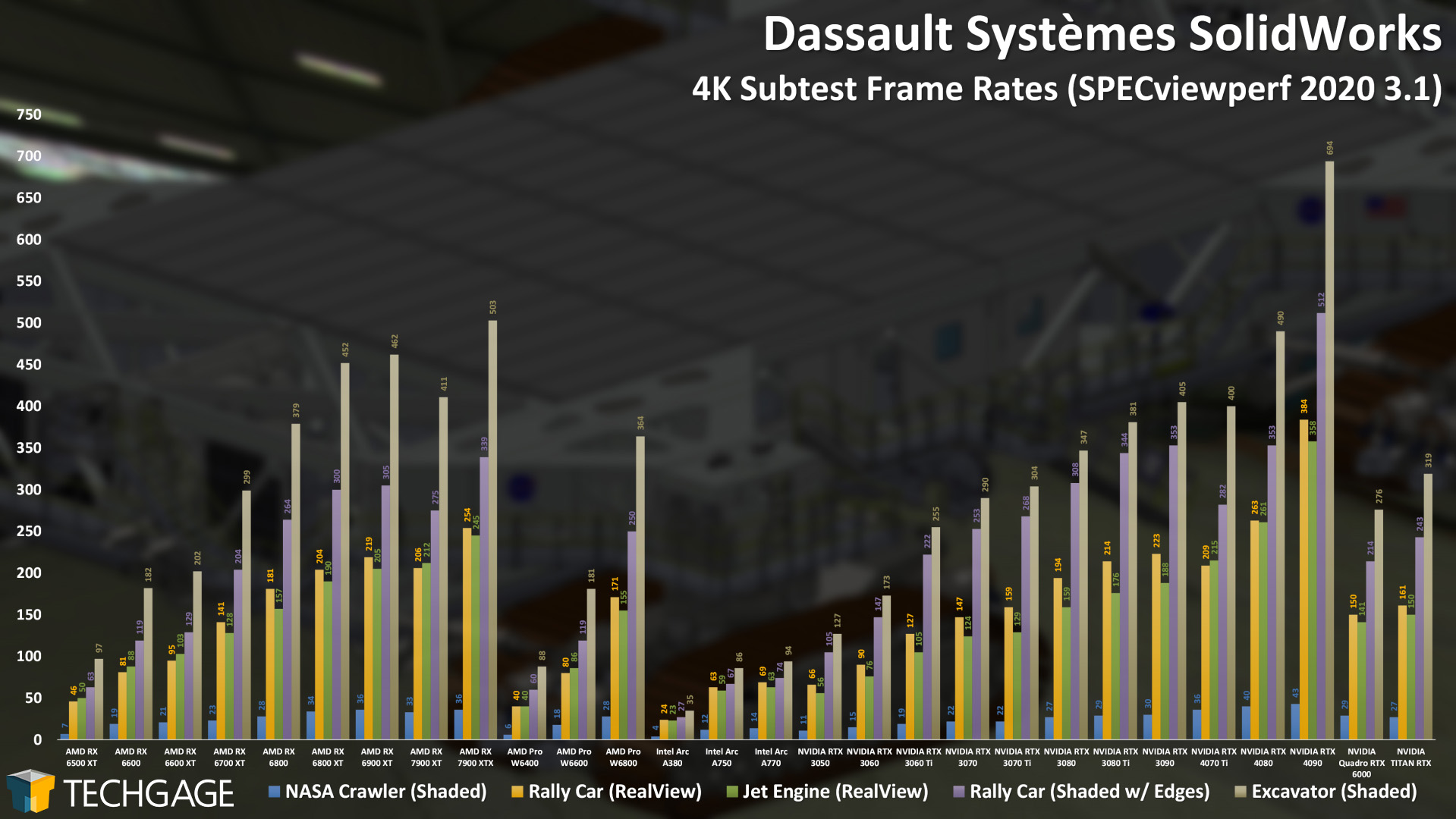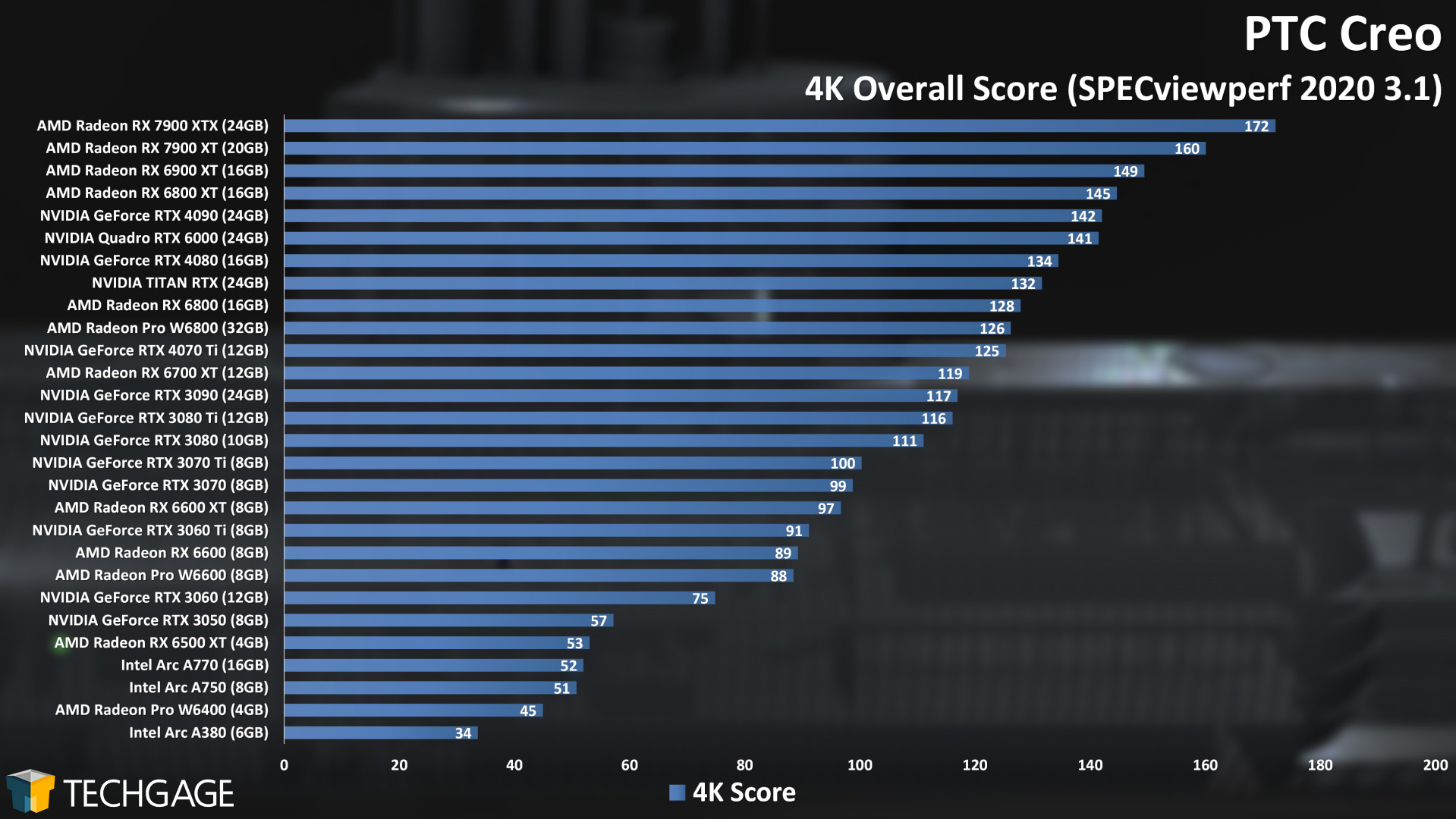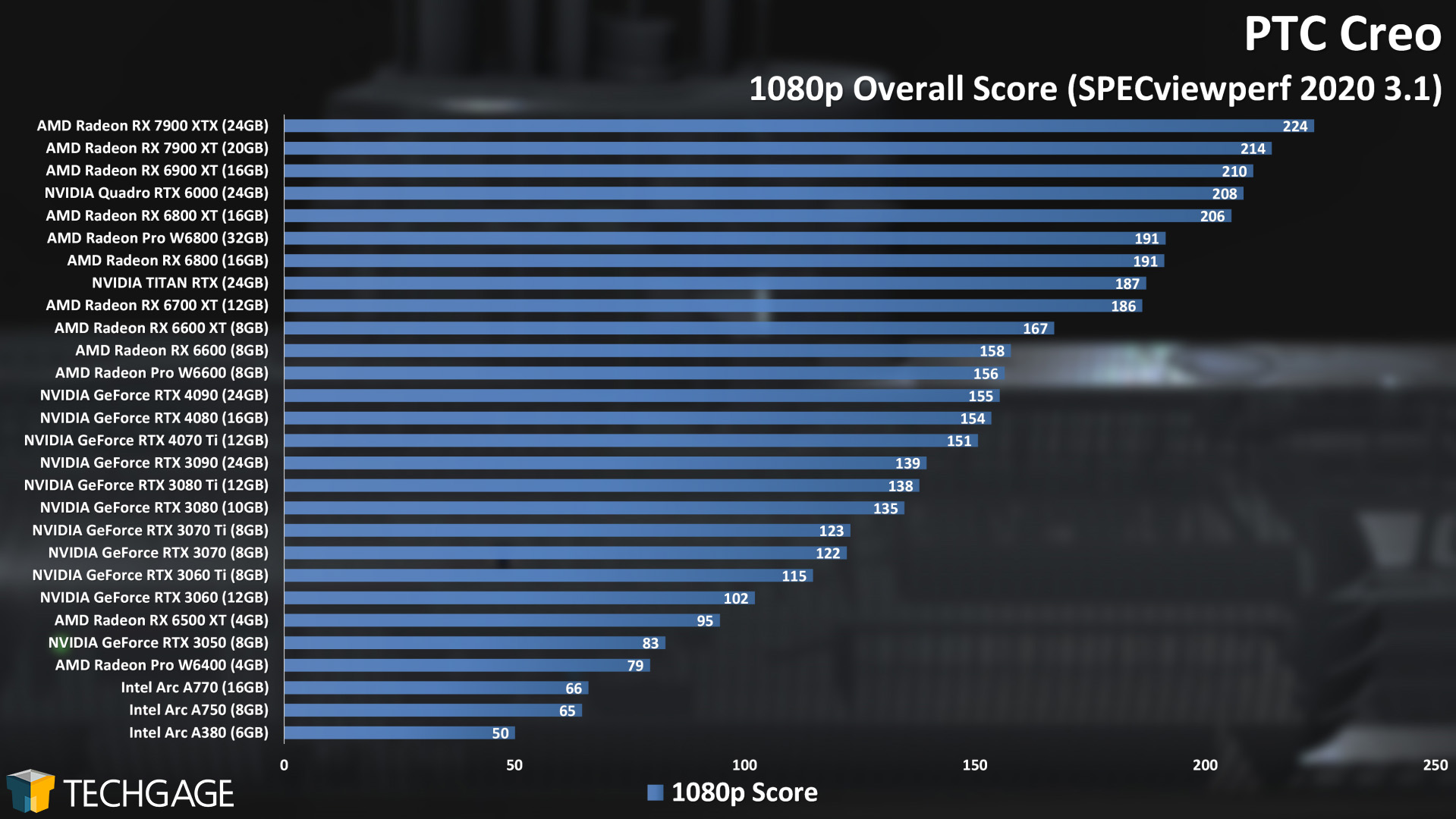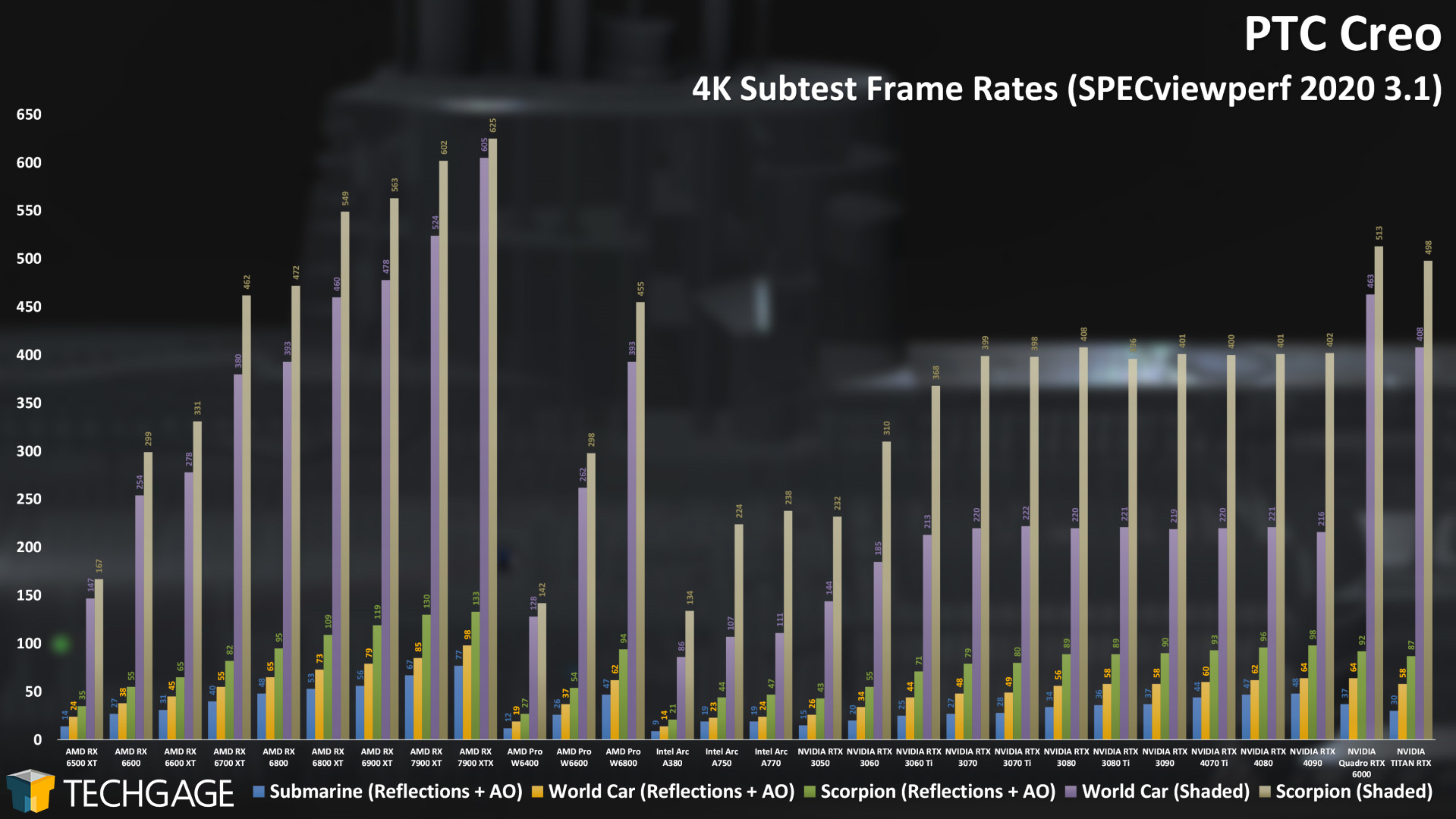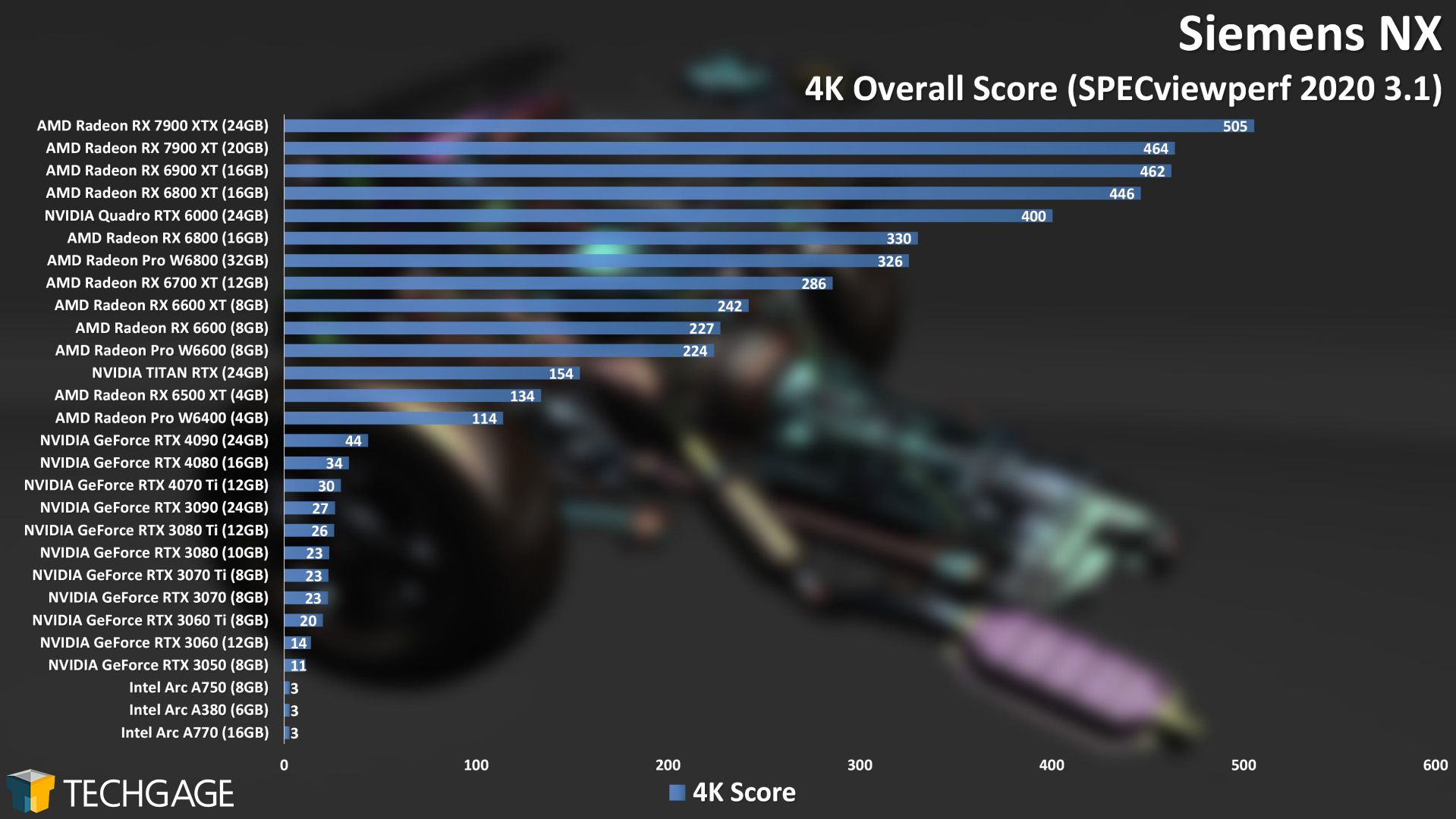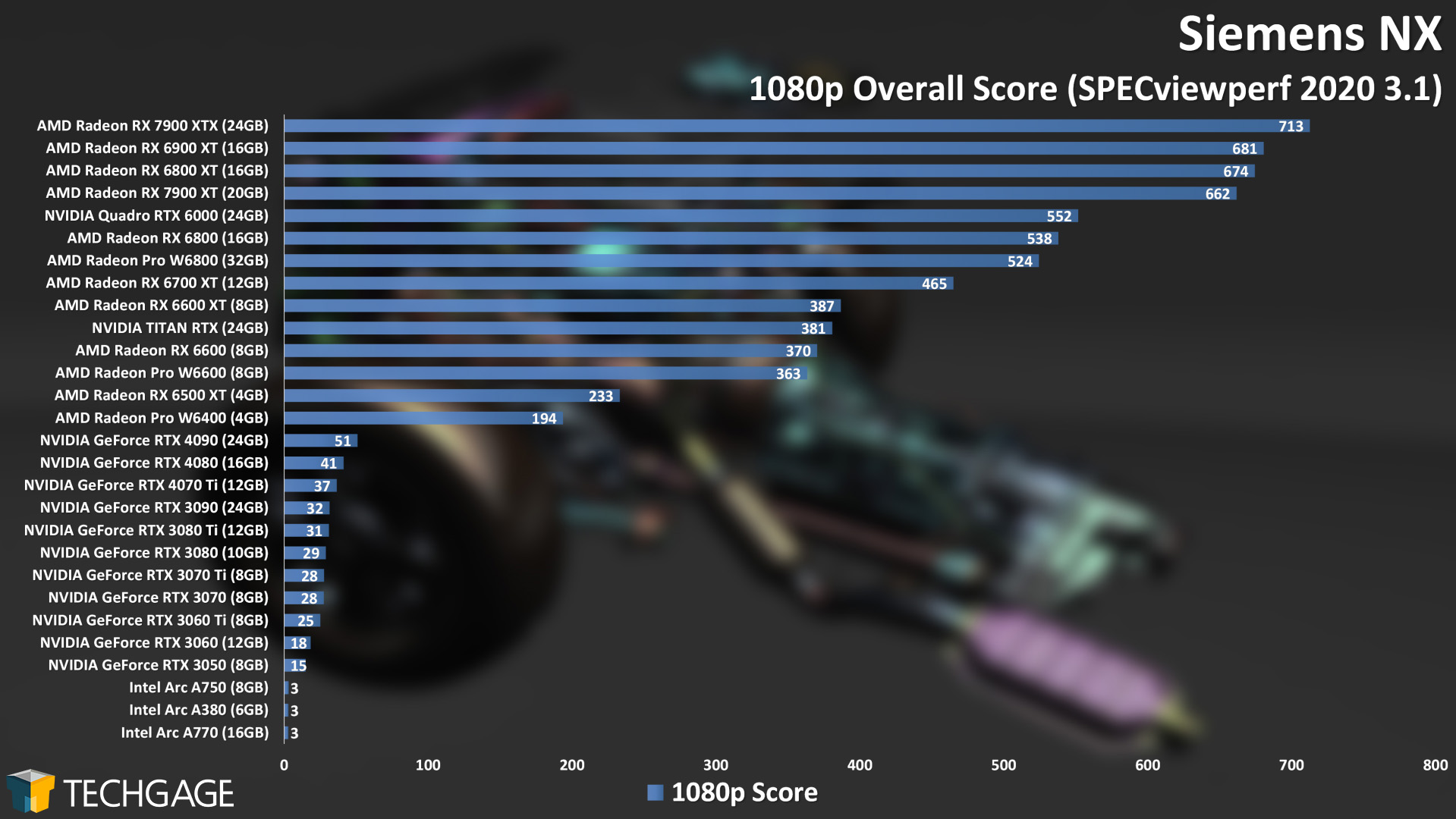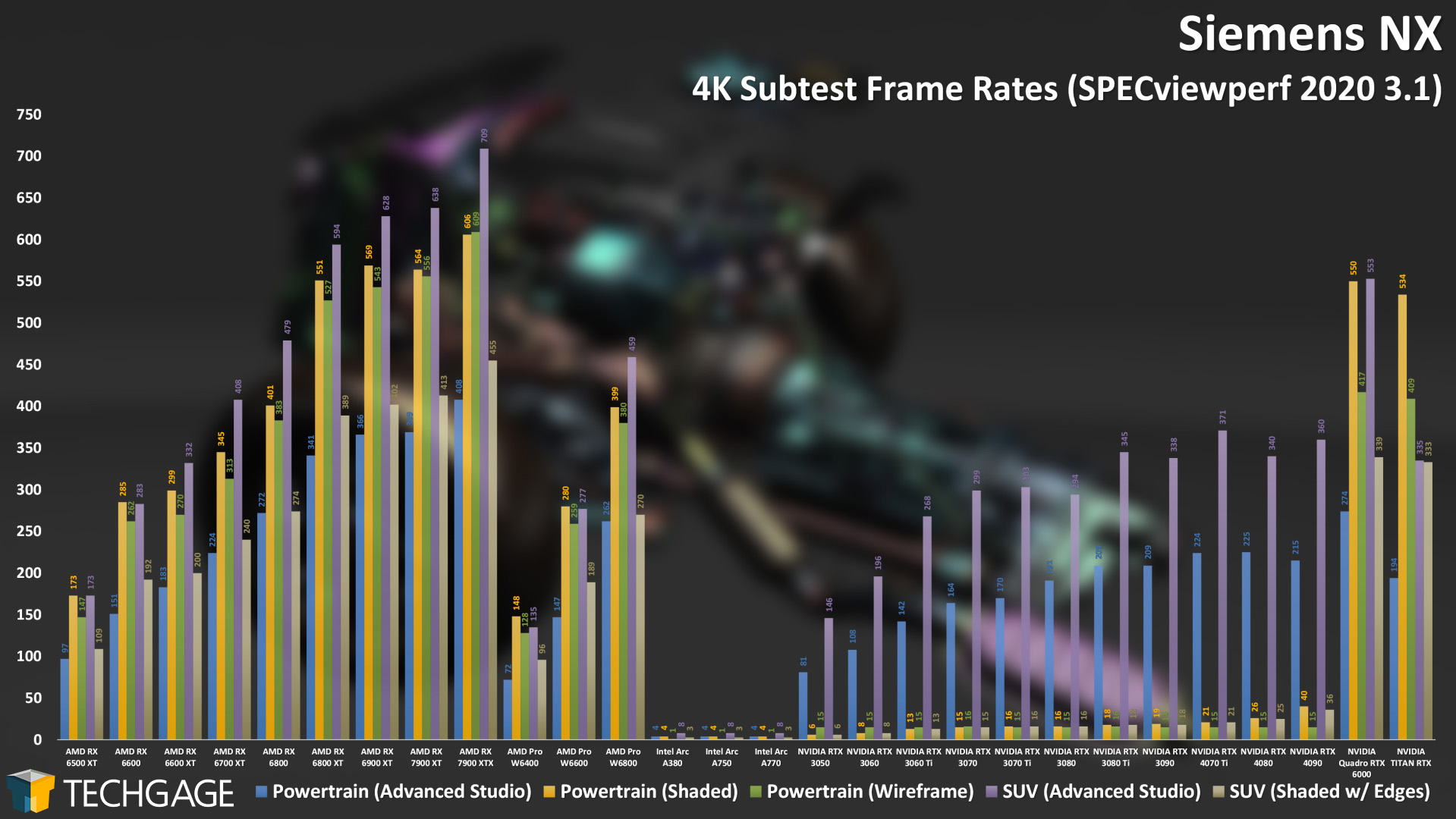- Qualcomm Launches Snapdragon 4 Gen 2 Mobile Platform
- AMD Launches Ryzen PRO 7000 Series Mobile & Desktop Platform
- Intel Launches Sleek Single-Slot Arc Pro A60 Workstation Graphics Card
- NVIDIA Announces Latest Ada Lovelace Additions: GeForce RTX 4060 Ti & RTX 4060
- Maxon Redshift With AMD Radeon GPU Rendering Support Now Available
Viewport Performance Look At CATIA, SolidWorks, SNX, Creo, 3ds Max & Maya

We’re taking a fresh look at the many workloads available in SPECviewperf. This time around, we’re taking a much deeper look at subtest results, to gain a better understanding of how SVP’s overall scores are generated. With the help of 28 GPUs, two resolutions, and 38 subtests, we have a lot of data to explore.
Page 1 – Viewport Performance: CATIA, SolidWorks, Creo & SNX
About six months ago, we posted a performance look at SPECviewperf in both Windows and Linux. Overall, the data gave us a lot to talk about, but in the months that followed, we began to realize that dissecting the overall score with the help of subtest data would be beneficial – and so, this article now exists.
For those unfamiliar with SPECviewperf, it’s a tool built by SPEC which tests the viewport performance of eight popular design suites – such as SolidWorks, Creo, and Maya. Through the use of application traces, SPEC is able to faithfully recreate playback of each software’s viewport to provide an accurate look at current performance. SPECviewperf is all-in-one, so no native software needs to be installed.
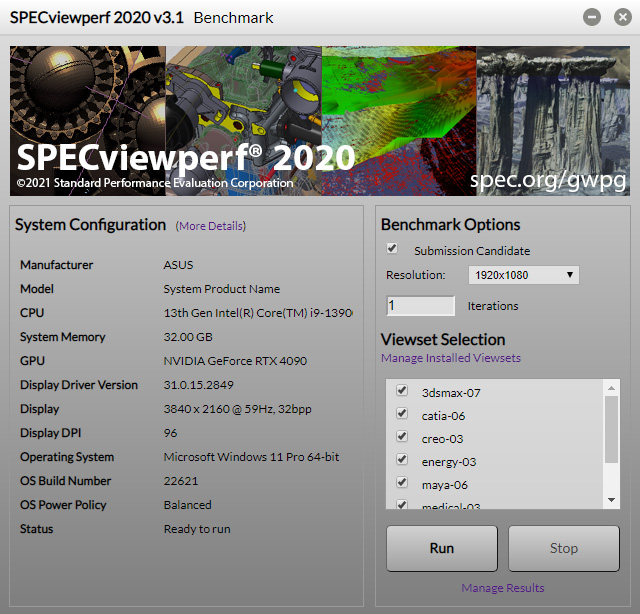
The main reason we wanted to produce this article is to better highlight scaling differences between different GPU models. SPECviewperf’s overall score is generated with questionable subtest weighting, so the scaling we see doesn’t often match what we see from our other GPU testing. The subtests, however, do provide a good impression of performance scaling across vendors and GPU models.
This article is only two pages long, but it’s one of the most data-heavy we’ve ever published. In all, 28 graphics cards ran SPECviewperf’s eight tests at two resolutions, giving us not just overall scores, but results for 38 subtests.
As a fair warning, some of the charts in this article have a lot of data in them, but we feel it’s important to look at everything in aggregate. It’s easier to grasp overall differences between GPUs and their respective vendors when the data can be seen all at once, versus trying to piece it together with four or five separate graphs.
For those who may be interested in Blender viewport performance, be sure to check out the second page of our recent Blender 3.4 deep-dive.
This page is going to focus on viewport performance in CATIA, SolidWorks, Creo, and Siemens NX, while page 2 covers 3ds Max and Maya, as well as Energy and Medical, for good measure.
All of the performance in this article was tested on the below Intel test PC:
| Techgage Creator GPU Testing PC | |
| Processor | Intel Core i9-13900K (3.0GHz, 24C/32T) |
| Motherboard | ASUS ROG STRIX Z690-E GAMING WIFI CPUs tested with 2204 BIOS (November 30, 2022) |
| Memory | G.SKILL Trident Z5 RGB (F5-6000J3040F16G) 16GB x2 XMP-enabled w/ freq. set to DDR5-6000 (30-40-40-96, 1.35V) |
| AMD Graphics | AMD Radeon PRO W6800 (32GB; Adrenalin 23.2.1) AMD Radeon PRO W6600 (8GB; Adrenalin 23.2.1) AMD Radeon PRO W6400 (4GB; Enterprise 22.Q4) AMD Radeon RX 7900 XTX (24GB; Adrenalin 23.2.1) AMD Radeon RX 7900 XT (20GB; Adrenalin 23.2.1) AMD Radeon RX 6900 XT (16GB; Adrenalin 23.2.1) AMD Radeon RX 6800 XT (16GB; Adrenalin 23.2.1) AMD Radeon RX 6800 (16GB; Adrenalin 23.2.1) AMD Radeon RX 6700 XT (12GB; Adrenalin 23.2.1) AMD Radeon RX 6600 XT (8GB; Adrenalin 23.2.1) AMD Radeon RX 6600 (8GB; Adrenalin 23.2.1) AMD Radeon RX 6500 XT (4GB; Adrenalin 23.2.1) |
| Intel Graphics | Intel Arc A770 (16GB; Arc 31.0.101.4125) Intel Arc A750 (8GB; Arc 31.0.101.4125) Intel Arc A380 (6GB; Arc 31.0.101.4125) |
| NVIDIA Graphics | NVIDIA Quadro RTX 6000 (24GB; Quadro 528.49) NVIDIA TITAN RTX (24GB; Studio 528.49) NVIDIA GeForce RTX 4090 (24GB; Studio 528.49) NVIDIA GeForce RTX 4080 (16GB; Studio 528.49) NVIDIA GeForce RTX 4070 Ti (12GB; Studio 528.49) NVIDIA GeForce RTX 3090 (24GB; Studio 528.49) NVIDIA GeForce RTX 3080 Ti (12GB; Studio 528.49) NVIDIA GeForce RTX 3080 (10GB; Studio 528.49) NVIDIA GeForce RTX 3070 Ti (8GB; Studio 528.49) NVIDIA GeForce RTX 3070 (8GB; Studio 528.49) NVIDIA GeForce RTX 3060 Ti (8GB; Studio 528.49) NVIDIA GeForce RTX 3060 (12GB; Studio 528.49) NVIDIA GeForce RTX 3050 (8GB; Studio 528.49) |
| Storage | WD Blue 3D NAND 1TB x3 (SATA 6Gbps) |
| Power Supply | Corsair RM1000x (1000W) |
| Chassis | Corsair 4000X Mid-tower |
| Cooling | Corsair H150i ELITE CAPELLIX (360mm) |
| Et cetera | Windows 11 Pro 22H2, Build 22621.1265 Intel Chipset Driver: 10.1.19222.8341 Intel ME Driver: 2242.3.34.0 |
| All product links in this table are affiliated, and help support our work. | |
While we don’t have explicit before and after test data to provide here, we’d like to highlight the fact that both AMD and Intel have made vast improvements to the viewport performance seen through SPECviewperf over the past year. An AMD update last September gave a huge boost in viewport performance on Radeon, thanks to a rewritten OpenGL driver. On the Intel front, recent driver releases have polished some of the performance in key tests, like Maya. Some viewports are still stifled on (gaming) Arc – as we’ll see – but the improvements we’ve seen over the past few months have been great.
This article aims to take a look at the as-is performance in each test across all of the tested GPUs, but we will mention that in some cases, a gaming GPU probably isn’t the best choice even if it happens to top the charts. A gaming GPU may run well in CATIA, for example, but when AMD, Intel, and NVIDIA work directly with the developers of these suites to cover every performance angle and then add optimizations to their dedicated workstation driver – and companies like Dassault ignore gaming GPUs in their support pages – it’s important to opt into a validated platform for crucial work.
With that covered, let’s kick things off with Dassault’s CATIA:
Dassault Systèmes CATIA
In terms of driver optimization, none of the three vendors appear to hold performance back on their gaming GPUs, which is nice to see. While NVIDIA’s GeForce RTX 4090 has the tendency to dominate many charts, it’s AMD’s RDNA3-based Radeon RX 7900 XT GPUs that sit on top.
While we don’t have any Intel workstation GPUs to compare against, the performance we see out of the Arc gaming cards is roughly what we’d expect. That said, AMD’s strengths in CATIA are notable when we see a lowly RX 6500 XT place ahead of the Arc A770 at 1080p.
A number of things can be gleaned from the subtest results above. When comparing the Radeon RX 6800 to the Radeon PRO W6800, we see nearly identical performance between them, so AMD clearly has no specific speed boosts applied to the PRO driver. The situation is different on the NVIDIA side; its workstation GPUs (furthest right) provide far better performance over technically superior GeForces when using an advanced shading mode.
While AMD placed at the top of the overall scores charts, there were occasions when NVIDIA placed ahead in the subtests, such as with the 3DEXPERIENCE shaded Loft Jet scene. There are exceptions, but it seems as though NVIDIA’s better at straight shaded mode, and AMD leaps ahead when edges or materials are involved.
On the Intel side, even without a proper Arc workstation card, we still get the impression that the company’s holding further CATIA optimizations for its dedicated workstation GPU line, as both of the advanced shaded tests score pretty much identically across the three SKUs. The regular shading modes on Arc seem to be standard fare, competitively.
Dassault Systèmes SolidWorks
AMD’s top-end Radeon RX 7900 XTX graphics card took the top spot in our CATIA overall score charts, with a notable lead over the runner-up. In SolidWorks, the top spot is switched up with NVIDIA, which shows an even greater leaping ahead being done with not just its RTX 4090, but also RTX 4080.
SolidWorks is another piece of software that suggests going with workstation GPUs for your work, but it holds nothing back in performance when using a gaming card, which is always appreciated.
Intel falls a little bit behind its expected competition, so once again, it’s useful to break things down and look at the subtests, as well:
There are no subtests here which show a distinct advantage between a gaming and workstation GPU, and when comparing the RX 7900 XT to its closest match-up, the RTX 4080, we see similar performance overall. The RTX 4090 is an anomaly of the entire bunch. It’s not often we see a top-end GPU perform so much better than the model behind it.
PTC Creo
When we think back to AMD’s RDNA1-based Radeons, which had a top-end model that went up against NVIDIA’s mid-range options, it’s great to see the company so competitive in many of these complex viewport workloads. We saw the RDNA3-based GPUs hit the top of the graph in CATIA, and we see the same thing happening here, with Creo. Even some of AMD’s last-gen top-end cards managed to edge out NVIDIA’s GeForce RTX 4090.
Intel’s Arc GPUs once again place a bit lower than we’d expect, so that means one thing: it’s time to dig deeper!
Creo is another one of those design suites where workstation GPUs are suggested, but thankfully, optimizations are neutral, allowing gaming cards to overtake the workstation ones if they are technically superior. This more neutral scaling gives us a nice stairstep effect across the graph.
We saw AMD top the overall scores charts, and we can see why in this breakdown. AMD does well in every single subtest, with most cards easily beating their most relevant (price-wise) competition. This is one situation where the Radeon RX 7900 XTX beats out NVIDIA’s GeForce RTX 4090. As for Intel, its GPUs sit further behind than expected, when comparing one relevant model to its nearest competitors.
Siemens NX
We’ve seen up to this point that choice of GPU vendor or even a specific model can dramatically impact performance in one test to the next, but no software spices things up as much as Siemens NX does. We’ve talked about the other suites on this page suggesting workstation GPUs over gaming ones, and Siemens NX is the most gaming GPU-agnostic of the bunch. As SNX is one of the most expensive suites of all tested here, opting for a workstation GPU with official support is recommended (unless you’re a student).
Gaming vs. workstation aside, these results are ridiculously interesting for so many reasons. We see both Intel and NVIDIA deliver held-back performance in comparison to AMD, but prior to last summer, AMD held performance back the same way on gaming GPUs, just with lesser dramatic effect.
Prepare yourself for the most entertaining graph of the entire article:
On the AMD side of the fence, driver optimizations are neutral across the stack, which allows the RX 7900 XTX to soar ahead of the workstation-focused PRO W6800. Meanwhile, on the NVIDIA side, top-end workstation GPUs from two generations ago are able to beat the top of the current GeForce GPUs because of those optimizations being held back.
The only area in which NVIDIA doesn’t hold back performance is with the Advanced Studio mode. In shaded, advanced shaded, or wireframe, GeForces just croak.
No GPUs croak more than Intel’s Arc here. Imposed performance limitations are so obvious, that all three Arc GPUs deliver the exact same frame rates across the five tests.
With these four heavy-hitters taken care of, the next (and final page) will evaluate viewport performance for 3ds Max and Maya, as well as Energy and Medical.
Support our efforts! With ad revenue at an all-time low for written websites, we're relying more than ever on reader support to help us continue putting so much effort into this type of content. You can support us by becoming a Patron, or by using our Amazon shopping affiliate links listed through our articles. Thanks for your support!




